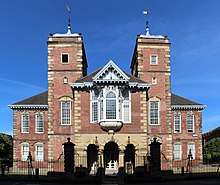Dame Allan's School, Newcastle upon Tyne
 | |
| Established | 1705 |
|---|---|
| Type | Independent day school |
| Religion | Church of England |
| Principal | Dr John Hind |
| Head of Junior School | Andrew Edge |
| Vice-Principals |
Alan Hopper Natalie Shaw |
| Founder | Dame Eleanor Allan |
| Location |
Fowberry Crescent Newcastle upon Tyne NE4 9YJ United Kingdom |
| Local authority | Newcastle upon Tyne |
| Students | approx. 920 |
| Gender | Coeducational; single-sex (Senior School) |
| Ages | 3–18 |
| Colours | |
| Former pupils | Old Allanians |
| Website | www.dameallans.co.uk |
Dame Allan's Schools is a collection of Independent schools in Fenham, in the west end of Newcastle upon Tyne, England. It comprises a coeducational junior school, single-sex senior schools and a coeducational sixth form. Founded in 1705 as a charity, the original schools are two of the oldest schools in the city.
History


They were founded by Dame Eleanor Allan, the daughter of a local goldsmith and the widow of a tobacco merchant, to provide a proper education for "40 poor boys and 20 poor girls of the parishes of St Nicholas and St John". The schools were endowed with land at Wallsend, to the east of Newcastle. The original school seems likely to have been near St Nicholas' Church, and certainly was by 1778.[1] It moved to Manor Chare near All Saints in 1786, to Carliol Square in 1821, to Rosemary Lane off Pudding Chare in 1861, and to Hanover Square in 1875.[1] The school then moved to College Street in Newcastle in 1883 and remained there until 1935 when it re-located to the present site in Fenham.[1]
Until 1988 the schools operated as separate boys' and girls' schools with a joint governing body. The governors then took the decision to appoint a principal with overall responsibility for the management of the two schools. At the same time, they created a joint mixed sixth form and reintroduced a mixed junior school. The plural, "schools", refers to the fact that Dame Allan's operates in a diamond format. In effect, Dame Allan's consists of 4 different schools: the co-educational Junior school for nursery to Year 6 are located in a separate building in Spital Tongues; the single sex boys' and girls' schools for years 7 to 11; and the co-educational sixth form (years 12 to 13).[2]
Facilities
A number of new classrooms were built between 2004 and 2005 to replace older facilities, with some intended specifically for the sixth form centre.[3] The Sixth Form Centre was opened by the Queen during an official visit on 14 October 2005 and was named the Queen's Building.[4]
September 2012 saw the opening of the new nursery and junior school in Spital Tongues.[5]
2015 saw Dame Allan's chosen as the recipient of a £250,000 grant to help fund a £500,000 project. The grant was given by the Reece Foundation which promotes the improvement of education in engineering, technology and related subjects. The new facility will build on the Schools' existing master class programme.[6]
Academics
All schools are private, and potential candidates must pass written exams and an interview. The fees are currently (September 2015) around £3,867 per term in the Main Schools and per term in the Junior Department. These fees include books and external examination entry fees, but do not include meals. Scholarships of up to 50% are available on the basis of academic merit, and bursaries of up to 100% are available on the basis of academic merit and financial need.[2]
Being a private school, Dame Allan's does not strictly adhere to the National Curriculum. It does enter all its students in public examinations such as GCSEs and A-levels, so the subjects taught are closely tied into their national counterparts. All students must study English, mathematics, and the sciences to GCSE level, and it is strongly recommended that at least one foreign language be studied to this level. Sixth form students have a much wider range of study, with no mandatory subjects and the introduction of many new subjects in year 12, including A-levels in politics, psychology, sports, business and theatre studies. Dame Allan's is an Anglican school.[7]
In 2005 the school recorded its best ever set of exam results, including a handful of Top 5 results in several subjects, notably GCSE languages.[8] Furthermore, two pupils were awarded 6 grade As at A-level. The school consistently performs to an extremely high standard in public examinations, with the girls' school often slightly outscoring the boys' school at GCSE level.[9] The school has not yet been inspected by OFSTED[10] but received a positive report from the independent schools Inspectorate in 2000.[11]
The 2000 inspection summarised the schools as "a civilised and civilising community ...[which provides] a well-rounded education for pupils from the age of 8 to 18"[11] and the 2006 report states "Dame Allan's are good schools with several great strengths and no significant weaknesses. The schools succeed very well in their key aims of providing a broad education for their pupils, where academic success is greatly valued but so is the moral, social and spiritual development of pupils."[12]
Notable former pupils
Former pupils are known as Old Allanians.
- Peter Pilkington (1933–2011), Conservative Peer and former Chairman of the Broadcasting Complaints Commission[13]
- Ian La Frenais (1937), writer[14]
- Dame Myra Curtis, Principal of Newnham College, Cambridge[15]
- Sir David Lumsden (1928), Choirmaster, organist and harpsichordist; former Principal of the Royal Academy of Music[16]
- Margaret Dale (1922–2010), dancer and television producer[17]
- David Leon (1980), actor[18]
- Edward Hinds FRS (1949), Professor of Physics[19]
- Marian Foster (1948), broadcaster[20]
- Professor Elizabeth Fallaize (1950–2009), Pro-Vice-Chancellor (Education), University of Oxford[21]
- The Right Reverend John Crook, former Bishop of Moray, Ross and Caithness[22]
References
- 1 2 3 "History of Dame Allan schools commemorated". The Journal. 2 November 2010. Retrieved 10 March 2018.
- 1 2 "Boys". Dame Allan's School. Archived from the original on 2006-05-09. Retrieved 17 August 2009.
- ↑ "Dame Allan's School website". Archived from the original on 9 May 2006. Retrieved 4 April 2006.
- ↑ "Crowning glory of our 300th birthday". The Chronicle. 12 October 2005. Retrieved 10 March 2018.
- ↑ Weatherall, Nicola (18 September 2012). "Dame Allan's School pupils get a blessing from the Bishop of Newcastle". The Journal. Retrieved 8 January 2017.
- ↑ "Reece Foundation". Dame Allan's School. Retrieved 20 August 2015.
- ↑ "Curriculum from dameallans.co.uk". Archived from the original on 29 September 2011. Retrieved 4 April 2006.
- ↑ "Top marks at Dame Allan's" (Press release). Dame Allan's School.
- ↑ "Newcastle-upon-Tyne league tables, 2005". BBC News. Retrieved 2 January 2010.
- ↑ "OFSTED reports for Dame Allan's". Archived from the original on 3 March 2006. Retrieved 4 April 2006.
- 1 2 "Independent Schools Inspectorate report, 2000". Independent Schools Inspectorate. Retrieved 4 April 2006.
- ↑ Independent Schools Inspectorate report, 2006
- ↑ Obituary The Daily Telegraph, 15 February 2011
- ↑ Richard Webster; Dick Clement; Ian la Frenais (2001). Porridge The Inside Story. Headline Book Publishing. ISBN 0-7472-3294-6.
- ↑ Mary Alvey Thomas (2004), "Curtis, Dame Myra", Oxford Dictionary of National Biography, Oxford University Press, doi:10.1093/ref:odnb/40538
- ↑ "Lumsden, Sir David (James)", Who's Who, online edition, Oxford University Press 2016. Retrieved 26 November 2017 (subscription required)
- ↑ Who Was Who in the Theatre:1912-1976 vol.2 D-H p.586; from editions originally published annually by John Parker..Retrieved July 2, 2015
- ↑ "Vera actor David Leon teams up with Boardwalk Empire's Stephen Graham for debut feature". The Chronicle. 23 February 2016. Retrieved 10 March 2018.
- ↑ "The Northern Echo: Prestigious awards for school's old boys". The Northern Echo. 4 November 2007. Retrieved 2009-01-25.
- ↑ "School record that will never be broken". The Journal. 15 August 2005. Retrieved 10 March 2018.
- ↑ "Elizabeth Fallaize obituary". The Guardian. 3 January 2010. Retrieved 10 March 2018.
- ↑ Who's Who 2008: London, A & C Black, 2008 ISBN 978-0-7136-8555-8
External links
- The findings of the most recent inspection of the Boys' Schools by the Independent Schools Inspectorate in 2006
- The findings of the most recent inspection of the Girls' Schools by the Independent Schools Inspectorate in 2006
- Official school website
- A brief review of schools in the area mentioning Dame Allan's